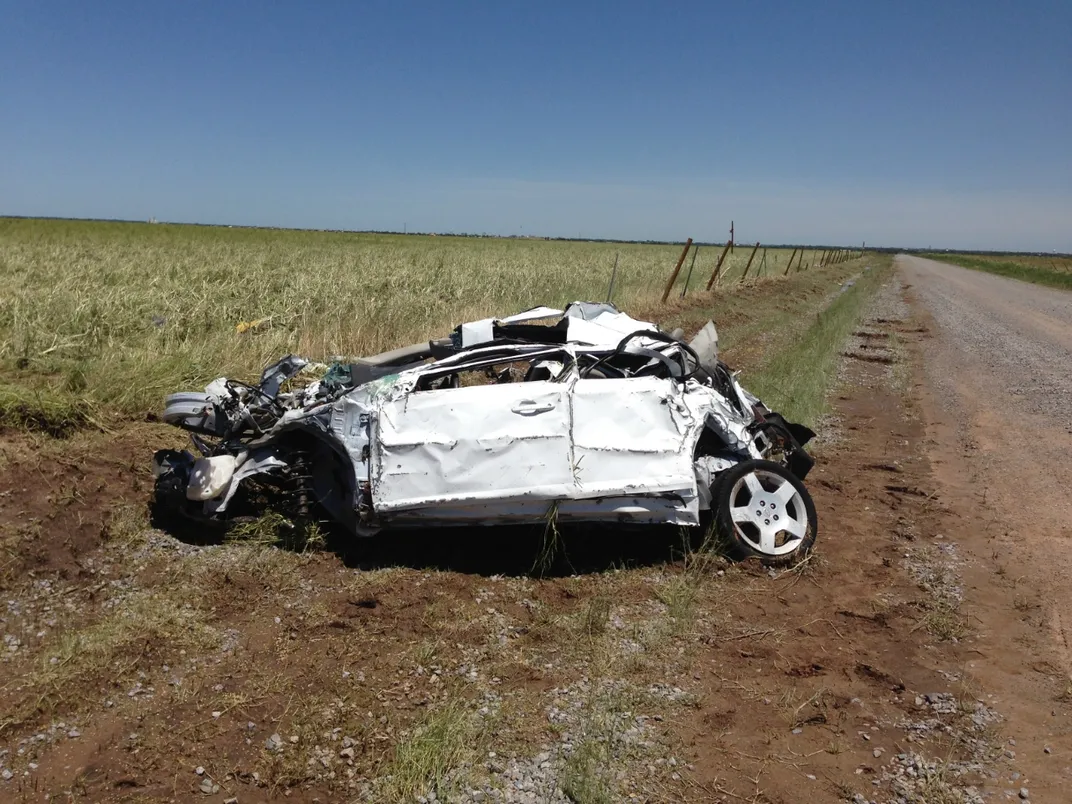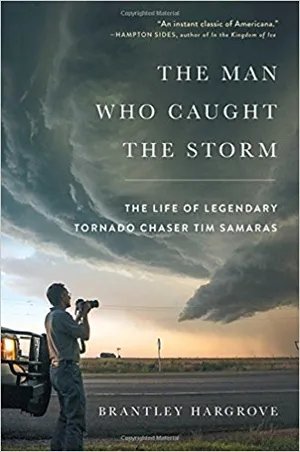How a Legendary Storm Chaser Changed the Face of Tornado Science
In 2013, Tim Samaras died in one of the epic storms he’d spent decades chasing. A new book chronicles his harrowing last days
/https://tf-cmsv2-smithsonianmag-media.s3.amazonaws.com/filer/1d/37/1d37df99-52cb-48a9-a322-df4b0bfd3f4b/hyamy0.jpg)
May 31, 2013 seemed like just another rainy spring day in El Reno, Oklahoma. The afternoon was hot, the air heavy with moisture. On the darkening horizon, thick clouds billowed in a promise of rain.
But around 4 p.m. local time, the winds shifted slightly and the afternoon shower turned deadly. Two hours later, the tornado that touched down defied weather experts’ predictions, rapidly changing speed and direction and swelling to record-breaking sizes. At its peak, researchers estimate that the twister spanned 2.6 miles across.
Over the course of its 40-minute rampage, the twister caused millions of dollars of damage, 115 injuries and 20 deaths. Each of those deaths was significant, but three were particularly unusual: the first storm chasers ever known to be killed in a tornado. The violent winds enveloped Tim Samaras, 55, his son Paul Samaras, 24, and his colleague Carl Young, 45, toppling their car like a toy in a breeze.
Their deaths may not seem surprising; storm chasing, as you might expect, has its risks. But Samaras was a seasoned chaser who pursued tornadoes for over two decades. As journalist Brantley Hargrove writes in his new book The Man Who Caught the Storm, Samaras worked to change the face of tornado science, helping researchers better understand how changes in pressure, humidity, winds and air temperature conspire to produce a phenomenon so powerful it can snap trees, flip cars or even derail a multi-ton train.
Throughout Samaras' career, he ventured ever closer to the deadly storms to deploy squat cone-shaped probes he engineered to measure the pressure, humidity and temperature in the heart of the tornado. But to do this, Samaras had to bend the chasers' one rule: "never get too close or too cocky," as Hargrove puts it.
Hargrove was a reporter for the Dallas Observer when he heard of Samaras' death. The 1996 drama Twister had loomed large in his teen years—and Samaras' story was like a real-life retelling of that suspenseful tale. "I had to know more about this guy," he tells Smithsonian.com. "Why did he get so close? What was he trying to accomplish out there?"
As Hargrove would soon learn, Samaras' dangerous work had good reason: he was trying to save lives. By getting ground-based data, he hoped scientists could better understand these tricky beasts, and use the information to hone their forecasts and design structures to withstand the roaring winds. As Samaras once stressed: A ground-based measurement from within the twister "is especially crucial, because it provides data about the lowest ten meters of a tornado, where houses, vehicles, and people are."
****
The twister that tooks Samaras' and his colleagues' lives is a testament to tornadoes’ complexity, and how much scientists have yet to learn. Currently, seven out of ten tornado forecasts from National Weather Service are false alarms, and the lead time on an oncoming twister is an average of just 13 minutes.
In the early half of the 20th century, tornadoes were deemed so unpredictable the word was forbidden from weather forecasts to prevent unnecessary outbreaks of hysteria. Progress on the forecasting front moved slowly until the 1970s, when the first Doppler radar scans illuminated the elements of these twisting storms. Scientists could track the storm's development and soon learned to spot the signs of a developing twister.
But there was still much to learn. As Hargrove writes, the Doppler can say nothing about temperature, humidity or pressure inside the tornado.
Since the 1970s, researchers had been attempting to measure these basic pillars of atmospheric science from the tornado's heart. These efforts include the TOtable Tornado Observatory (TOTO) project, the inspiration for the movie Twister. But many of these devices weighed hundreds of pounds, making them impractical to move in the few heart-pounding moments a chaser has to deploy. Others simply couldn't withstand the tornado's winds, which have been measured up to around 300 miles per hour.
Many factors can affect the developing tornado—from changes in air temperature to the tug of nearby storms. And unlike hurricanes, which can be spotted days off shore, tornadoes develop over the course of hours or minutes, which makes taking on-the-ground measurements even more challenging. As Hargrove says, "tornadoes are creatures of variability."
That's where Samaras came in.
****

Samaras, born in Lakewood, Colorado, was curious from the start. "He was always taking apart his parent's appliances to see how they fit together, how they worked," says Hargrove, who interviewed Samaras’ family members for the book. He became an amateur radio operator, using parts of discarded electronics to build transmitters. He also had a lifelong love of storms and weather, sparked by a childhood obsession by the twister that swept up Dorothy and Toto in The Wizard of Oz.
Despite his curiosity, Samaras never took to the classroom environment and didn’t pursue a college degree. Instead, he got a job at the Denver Research Institute fresh out of high school, where he tested explosive weapons systems and ran a suite of high-end electronics to characterize the blasts. The position was a dream for Samaras, but his love of storms kept calling him back.
His foray into chasing was cautious and methodical, including his enrollment in a basic meteorology program in 1990. It turned out he had a talent for spotting the subtle signs of a developing storm, reading the twister's moves as if the winds whispered directions in his ear. He'd record every moment of his pursuit, later selling the videos to weather stations.
Samaras soon became known as "the guy who always gets the killer shot," Hargrove writes. But, he continues, "Tim [had] never been content to merely observe."
In 1997, mechanical engineer Frank Tatom asked Samaras to deploy a seismic sensor—dubbed the snail—near a tornado. It was a test of an early warning system that never panned out. But after that first taste of studying the mechanics of storms, Samaras was hooked. He later spotted a NOAA call for proposals to develop an instrument that could withstand the conditions within the tornado—and he couldn't help but answer.
After studying these failed systems, Samaras entered the fray in the early 2000s with his newly designed probe, the Hardened In-situ Tornado Pressure Recorders (abbreviated as HITPR, but often referred to as "the turtle"). At the time, scientists had largely given up the effort to see inside the tornado's core, explains William Gallus, professor of geological and atmospheric sciences at Iowa State University.
"I thought it had been decided, 'Okay, this just does not work,'" says Gallus. "And it was like Tim didn't get the memo."
In 2003, after many failed attempts, Samaras deployed his probe in the small community of Manchester, South Dakota, ahead of an EF4 tornado (the "Enhanced Fujita" scale is based on the relative damage to structures, rating the tornadoes intensity with the greatest being an EF-5). As Hargrove describes in his book, Samaras' probe got a direct hit, withstanding winds that roared like Niagra Falls. The probe recorded a pressure drop of 100 millibars, the largest ever seen inside a tornado.
"He was the talk of the meteorological world after that," says Hargrove.
At the time, Gallus had been collaborating with Partha Sarkar, an engineer trying to develop structures that could better withstand tornadoes. To study twisters in detail, Sarkar and his colleagues built a tornado simulator, and believed Samaras' peek inside the twister was just what they needed to test the accuracy of their simulation.
Gallus approached his meeting with Samaras with great trepidation, fretting his engineering collaborators would be disappointed. "This guy's going going to be some cowboy," he recalls thinking before the meeting. But Samaras' visit whisked away all his worries. "He was super humble, super nice, very smart," says Gallus. Crucially, he could speak the language: "He was communicating with the engineers in engineer-ese."
From that day on Samaras collaborated with Gallus and Sarkar, attempting to secure the data they so desired. Samaras later assembled a crew of researchers and videographers who traveled under the title of TWISTEX (Tactical Weather Instrumented Sampling in/near Tornadoes EXperiment). With his team, Samaras captured stunning video from inside the tornado and pressure data from several successful deployments of the turtle probes.
Samaras' work left an indelible mark on the meteorologic community. "You can't say that he got us the holy grail and he answered a million questions," says Gallus. "But … he opened up a whole new area for possible research."
As Gallus notes, researchers really need direct measurements of wind speed—not just pressure—inside the whirling gales. And as with all science, they need repetition of the measurements at multiple points through the storm and of tornadoes of different strengths. But Samaras at least proved it was possible—and important—to get these ground-based measurements.
Scientists are slowly making headway, Gallus says. "Now we're taking little bites out of the puzzle and starting to learn some of what Tim was trying to do; what the winds are doing," he says. For example, Josh Wurman, an atmospheric scientist at the University of Colorado, Boulder, recently collected measurements that support existing computer models, which suggest the strongest winds are actually tens of feet above the ground, the optimum height for peeling roofs from houses.
But these measures were all from weak tornadoes, and they need similar data from storms of many strengths to say whether the pattern will hold, says Gallus.
This work is becoming more important than ever, Hargrove writes. Some studies suggests tornadoes may have become more intense in recent years. Though it's not easy to pin the trend on changes in climate, it's certainly a troubling possibility.
****
Many couldn't believe that in the end, a storm caught the legendary storm chaser. "It was just devastating," says Gallus. "Everybody would have said [Samaras] was the safest person out there."
That may have been true. Recreations of the chase in El Reno suggest that a calamitous series of choices and developments doomed the chasers; they were essentially in the "wrong place at the wrong time," says Hargrove.
But unlike researchers affiliated with universities, Hargrove notes, Samaras' plucky crew of upstarts didn't have access to fancy mobile doppler equipment, which provides near real-time updates of the developing storm. That equipment clued Wurman in to call off his crew from the chase that day, while Samaras continued into the confusing twists and turns of the tornado.
Late in the afternoon of May 31, 2013, at the beginnings of the team's ill-fated venture, Samaras took to Twitter, writing:
Storms now initiating south of Watonga along triple point. Dangerous day ahead for OK--stay weather savvy! pic.twitter.com/B8ddJcDViI
— Tim Samaras (@Tim_Samaras) May 31, 2013
Regardless of the exact factors at play, Samaras’ death has left a void in the field. And his note serves as an eerie reminder that there's still more to learn about the these swirling gales. As Hargrove says: "The sky still has the power to surprise us."
The Man Who Caught the Storm: The Life of Legendary Tornado Chaser Tim Samaras
The Man Who Caught the Storm is the saga of the greatest tornado chaser who ever lived: a tale of obsession and daring, and an extraordinary account of humanity’s high-stakes race to understand nature’s fiercest phenomenon.
A Note to our Readers
Smithsonian magazine participates in affiliate link advertising programs. If you purchase an item through these links, we receive a commission.
/https://tf-cmsv2-smithsonianmag-media.s3.amazonaws.com/accounts/headshot/Wei-Haas_Maya_Headshot-v2.png)

/https://tf-cmsv2-smithsonianmag-media.s3.amazonaws.com/accounts/headshot/Wei-Haas_Maya_Headshot-v2.png)